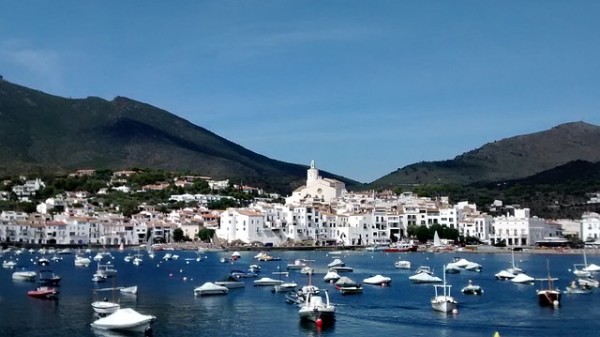The very northern Costa Brava lies in the comarca of Alt Empordà, where Catalonia borders with France.

Cadaqués is one of the best known towns of the Alt Empordà
The character of the Alt Empordà coastline varies between the rocky Cap de Creus, the most easterly point of the Iberian Peninsula formed from the foothills of the Pyrenees, and the long sandy beaches in the bay of Roses towards the south.
While starkly beautiful in the north (and the inspiration for much of Salvador Dalí’s work), it can also be bleak in the winter thanks to the intense cold and powerful tramuntana that sometimes gusts at more than 100 km/h.
The Alt Empordà was created in 1936 when historical region of Empordà was divided into two comarcas (counties). And as the most important city for trade in the area Figueres became the capital.
Today the area is popular with the French due to the proximity of the border with France and many locals speak fluent French in addition to Catalan and Spanish. The area is also popular with tourists from Germany, Holland and Belgium.
While close to the border, it’s not altogether straightforward to cross because of the Pyrenees. Although the railway cuts through the rock, Cerbère, on the other side of the border, is reached from Portbou by car via a winding mountain road.
Natural parks
Several areas here are protected by law. Nature lovers will want to visit the Parc Natural dels Aiguamolls de l’Empordà, marshland with numerous bird species. Among the birds there is a colony of storks with their huge nests. It’s definitely worth spending a morning or afternoon there, but best done when it’s not too hot. Basically any time but summer.
Apart from the sheer beauty of the place and dozens of coves to visit on foot or by sea, Parc Natural del Cap de Creus has a number of dolmens and other megalithic monuments you might want to see. And while Parc Natural del Montgrí, les Illes Medes i el Baix Ter is mainly in the Baix Empordà it starts in l’Escala. It’s an area of land between the port that runs on towards Montgó right next to the sea. At one time a military base, the area still has a couple of former gun emplacements. It is partly pine covered with a cliff top path that drops down, at one point at least, to a rocky beach.
Archeology and history
Apart from its spectacular scenery, the Alt Empordà is also notable for the Greco-Roman settlement of Empúries, near l’Escala. Founded by Greek settlers in around 550 BC, the city became largest Greek colony in the Iberian Peninsula. Later later it became part of the Roman Empire. Archeological work on the site began in the early 20th century and is ongoing. Other historical sites include the ruined Citadel of Roses and the castle at Peralada, while you can find the monastery of Sant Pere de Rodes high in the hills between Port de la Selva and Llançà.
Notable people from the Northern Costa Brava
The best known native of the Alt Empordà is Salvador Dalí. The surrealist was born in Figueres where there is a museum dedicated to his work. He also owned a house at Portlligat and a castle at Púbol in Baix Empordà. All three are open top the public. The museum in Figueres is located in the old theatre and easily spotted from a distance. Large eggs decorate the roof and loaves of bread cover the walls!
Less well known to Anglophones is Caterina Albert, who wrote under the pseudonym Victor Català. A native of l’Escala, you can visit her grave in the municipal cemetery. The house in which she was born still stands, as is the house given to her to recognise her literary output. The latter is now a museum dedicated to the author.

